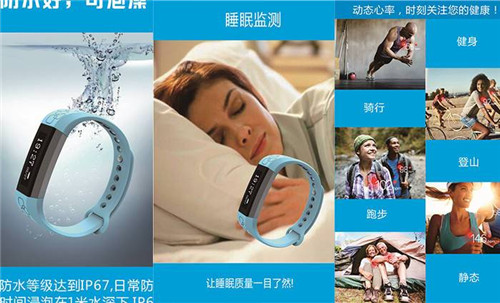Most fitness bracelets, even the most sophisticated fitness tracking bracelets on the market, are not just counting your steps or measuring your heart rate. But researchers have developed an intelligent bracelet that can do more: it's built into a headband or wristband that monitors chemicals in body sweat, can be used to noninvasively assess medical conditions, identify drug abuse, or help coaches and trainers optimize the performance of elite athletes, say scientists.
Wearing electronic smart Bracelet health test
Wearable electronics may be a fad in health awareness, but the functions of these devices, many of which are worn on the wrist like smart bracelets are usually limited to calorie burning based on heart rate or travel distance. But every active person has a lot of information to do: sweat. Human sweat is full of material that betrays the internal material.
We can make full use of sweat information. The device has two main parts. Some of them are made of flexible plastics and contain smart hand rings with custom sensors that measure sodium and potassium ions, key electrolytes for sweat production, and concentrations of glucose and lactic acid, allowing a better understanding of what happens in human cells. At high levels in cells, lactic acid, a negatively charged ion from lactic acid, accumulates when the cell lacks enough oxygen, destroying the body's pH balance. The smart bracelet of the temperature sensor helps to calibrate the information collected by other sensors. Another part of the device is a flexible circuit board, including 11 ready-made high-end smart Bracelet chips.

Smart Bracelet creative try to tap sweat
The creativity of the smart bracelet is preceded by the attempt to tap the sweat problem: flexibility and computational power. In the past, engineers using silicon-based computer chips have found that inflexible parts often do not keep in touch with human skin. Other teams using flexible plastic smart bracelets have found that those who do not usually have the computational power required to measure a variety of substances or those that include more than simple functions.
Jason Hackenfield, an electrical engineer at the University of Cincinnati in Ohio, said no one else measured many things at the same time, and he was not involved in the project. "Every time you can measure something else, smart Bracelet becomes smarter."
Functional test of new smart Bracelet
Researchers report today in the online edition of the Journal Nature that the smart bracelet functions as predicted in laboratory tests. In addition to being portable and non-invasive, the prototype monitors chemicals in real time, eliminating the usual time and effort required to collect samples and deliver them to the laboratory for analysis using large, expensive equipment.
"The ability to continuously monitor sweat provides new capabilities," says John Rogers, a materials scientist at the University of Illinois at Urbana-Champaign. In addition to basic research in human physiology, including how people respond to exercise or other stresses, the device can also be used in a variety of clinical situations. Doctors can monitor everything from depression to drug use and customize smart bracelets to measure the breakdown of drugs and biomarkers.

Alternatively, the device can monitor the speed or speed of an individual patient's response to a drug during treatment with an intelligent hand ring over a period of time, enabling doctors to customize the dose. The device can also be used to warn athletes and patients of various medical conditions, including fatigue, dehydration and overheating. At present, the prototype board of the team is very large.But the 11 computer chips used by the researchers could be integrated into a custom smart ring chip, making future versions of the device smaller and usable for infants and children as well as adults. In addition, the next generation of smart bracelets also have the ability to disconnect and process sensors, but retain and reuse electronic smart bracelets.
Commercializing a team's equipment into a medical product requires lengthy clinical testing and evaluation - a process that may take years to complete.

Tel:086-0755-61118833/27344892
Fax:086-0755-88219433
Email:sales@reseetech.com
URL:www.reseetech.com.cn、www.reseetech.com
Address:Room 1102,Building 22, Shapu Wai Community Entrepreneurship Industrial Zone, Songgang Street, Baoan District, Shenzhen City, CHINA
